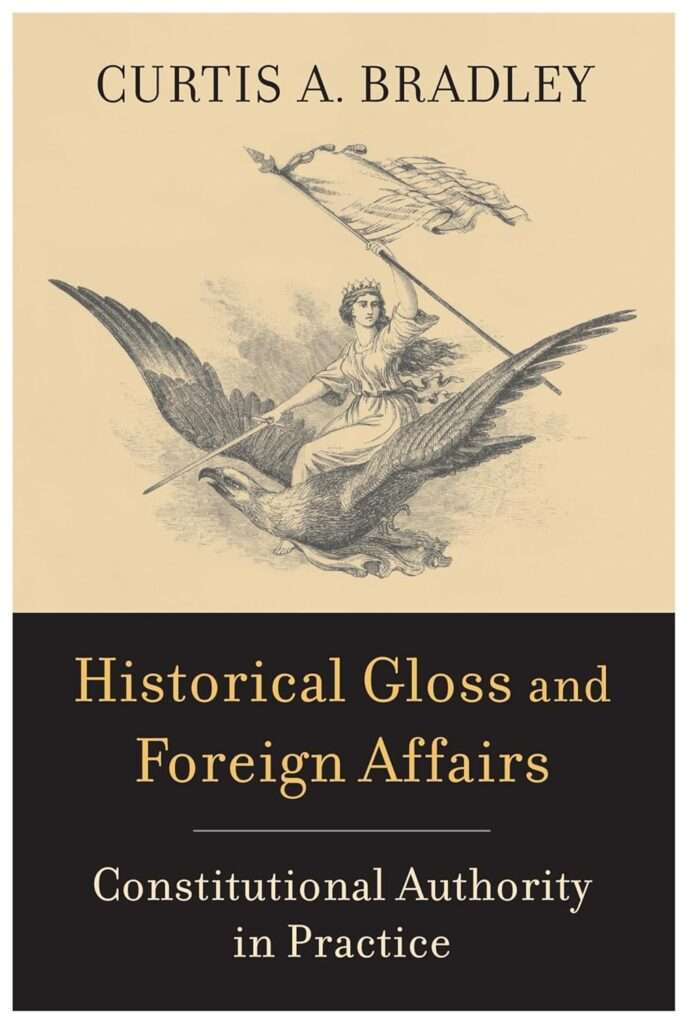 This is the second of five posts about my new book, Historical Gloss and Foreign Affairs: Constitutional Authority in Practice. In the first post, I addressed some general points about the role of historical gloss in constitutional interpretation, and I explained why gloss has had particular relevance in the foreign affairs area.
This is the second of five posts about my new book, Historical Gloss and Foreign Affairs: Constitutional Authority in Practice. In the first post, I addressed some general points about the role of historical gloss in constitutional interpretation, and I explained why gloss has had particular relevance in the foreign affairs area.
In this post, I discuss the phenomenon of executive agreements.
Article II of the Constitution describes how treaties are to be made: by the President with the advice and consent of two-thirds of the Senate. But from early in our history, presidents have sometimes concluded international agreements through other processes.
Agreements concluded with either the ex ante or ex post approval of a majority of Congress are sometimes referred to as “congressional-executive agreements” and those concluded based solely on the President’s authority are sometimes referred to as “sole executive agreements.” The term “executive agreements” is used in the United States to distinguish them from agreements concluded through the Article II process, but under international law these are all treaties.
There were executive agreements even in the early days of the nation, but the practice grew over time. According to one widely cited calculation, in the first fifty years after the adoption of the Constitution, the federal government concluded 60 Article II treaties and only 27 executive agreements. The executive agreements concerned matters such the international exchange of mail and the settlement of American claims against foreign governments.
By contrast, in the fifty-year period from 1939 to 1989, there were, according to a State Department calculation, 702 Article II treaties and 11,698 executive agreements. In other words, executive agreements constituted almost 95% of the overall international agreements during that period.
This trend has continued during the last several decades. In fact, in recent years the use of the Article II treaty process has slowed to a trickle, so almost all binding international agreements concluded by the United States have been executive agreements.
As I explain in the book:
Part of the reason for the substantial growth in executive agreements, especially after World War II, has been practical necessity: as the United States became a major world power, and as international affairs became more complex, the executive branch needed to conclude many more agreements than could reasonably be considered by the Senate. The House, moreover, insisted on a role in the making of international agreements, as such agreements increasingly addressed matters relating to congressional prerogatives. Both Congress and the executive branch responded by developing alternatives to the Article II treaty process.
When the Supreme Court has considered cases involving executive agreements, it has upheld them, in large part because of historical practice.
To take one example, in upholding an executive agreement made by President Jimmy Carter settling the Iran hostage crisis, the Court in Dames & Moore v. Regan (1981) noted that, although agreements settling claims with foreign nations have sometimes been made by treaty, “there has also been a longstanding practice of settling such claims by executive agreement.”
Not surprisingly, the executive branch also relies heavily on practice in defending the legality of these agreements.
For example, a 1994 Office of Legal Counsel memorandum defending the legality of the GATT trade agreement (which was concluded through majority congressional approval rather than two-thirds senate consent) argued that “a significant guide to the interpretation of the Constitution’s requirements is the practical construction placed on it by the executive and legislative branches acting together.”
The chief debate today is not over whether executive agreements are constitutional as a general matter, but rather over the extent to which they are interchangeable with Article II treaties.
Executive agreements (especially congressional-executive agreements) are used for a wide range of subject areas, but not all of them. The Senate has successfully insisted, for example, that arms control and human rights agreements be processed as Article II treaties. And practice suggests that the permissible use of sole executive agreements is substantially narrower than for Article II treaties.
As I conclude in Chapter 4 of the book:
Although it seems settled that congressional-executive agreements are generally constitutional, the practice does not yet support complete interchangeability of these instruments with Article II treaties. In addition, although it seems settled that presidents have some authority to conclude sole executive agreements—to resolve American claims against foreign governments, for example—the bounds of this authority are unclear and sometimes contested, and practice does not suggest anything like full interchangeability of these agreements with Article II treaties.
Without denying that there are boundary lines, the courts so far have been content to let the political branches work them out.
The book also contends that the historical gloss account of the rise of executive agreements is more descriptively accurate than accounts focused on a particular “constitutional moment,” such as a moment in the mid-1940s when there was extensive debate about the legitimacy of executive agreements:
It is true … that most ex post congressional-executive agreements have been concluded since World War II, but some of these agreements occurred earlier, and in any event, those agreements are a small part of the executive agreement landscape (only about one per year in recent decades). The vast majority of executive agreements today are ex ante congressional-executive agreements, a type of agreement that can trace its lineage back to the 1790s. Moreover, the debates in the 1940s, while an important part of the history, did not in fact settle core issues, such as the extent to which congressional-executive agreements (whether ex ante or ex post) are interchangeable with Article II treaties. Historical gloss provides a better account of constitutional development in this area.




